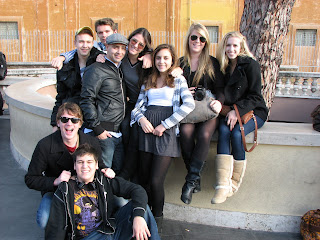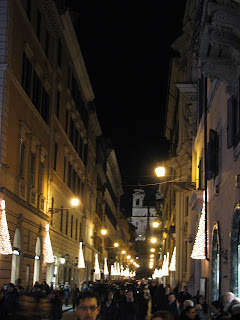December 7, 2010
Our last excursion for the semester took us to Rome, this time to see sacred Christian sites. One group toured the Basilica of San Clemente while the other concentrated on the Vatican and St. Peter’s.
San Clemente is of special importance. St. Clemente is reputed to be the third bishop in Rome after St. Peter. The church that bears his name is a 4th C Basilica, built on top of another which was deemed unsafe for occupancy about 1100 A.D. and is in turn, built on top of a Mithriac temple used by the ancient Romans. Excavations begun in the 18th C have revealed all three layers of construction to present day visitors.
Mirthras was a Persian religion and a secret cult for men, many of whom were soldiers. Only initiates knew what the religion was about. Mirthriums are found all over the Roman Empire. Many like this one have survived because they were in caves or underground buildings.
It was a warm, beautiful day for a walk along the Circus Maximus, one of the oldest entertainment centers in Rome and older than the Colosseum. Charioteers who were successful became rich and famous. The Eastern Goths in 541 outlawed the tradition of chariot racing that had lasted 1150 years in Rome.
Bocca della Verita, “The Mouth of Truth” was made famous by Audrey Hepburn and Gregory Peck in Roman Holiday. Medieval lore said that anyone who was accused of a crime or who had given an oath had to put their hands into the open mouth of this ancient Triton mask. If the person had not told the truth their fingers would be bitten off. All of our CCI students were truthful and survived, fingers intact.
The mouth is in the porch of S. Maria in Cosmedian which also holds the bones of Saint Valentine. The students visited the crypt which had just been opened to the public. It is reputed to be the oldest Christian church in Rome.
While in the Forum Boarium, the site of the one of the oldest markets in ancient Rome, we stopped to admire one of the oldest buildings in Rome, a round temple dedicated to Hercules Victor, probably built by the oil dealers who worshipped Hercules as their divinity.
The walk continued along the Tiber and over to Isola Tiber (Tiber Island) the narrowest part of the Tiber, where the first bridge was built in ancient times.
The walk continued along the Tiber and over to Isola Tiber (Tiber Island) the narrowest part of the Tiber, where the first bridge was built in ancient times.
Finally, they walked through the area known as the Jewish Ghetto where the Menorah was set up for Hanukah and finished at in Piazza Navona where a Christmas market was in full swing.
The second group toured the Vatican and the Basilica of San Pietro, (St. Peter’s Basilica).
The Vatican derives its name from the Vatican Hill on the bank of the Tiber River. It has been the seat of the Roman Catholic Popes since the 14th C. The present boundaries of the Vatican were set on February 1, 1929. It is the smallest sovereign state in the world measuring less than half a square kilometre. For hundreds of years it has been protected by the Swiss Guard who to this day wear uniforms designed by Michelangelo.
St. Peter’s Square and the Basilica stand on what was originally a site for Nero’s circus. An obelisk remains from those days. Many Christians were martyred there as was Peter, Christ’s apostle. In due course, the Emperor Constantine built a church over Peter’s burial site. The original church was demolished and replaced by the one that stands today. The task of overseeing its construction was given to Michelangelo, when he was 72 years old. The famous dome was designed by Michelangelo who modelled it after Brunelleschi’s dome in Florence though it is slightly smaller in size.
Inside the basilica was wonderful works of art. Michelangelo’s Pieta though carved earlier when he was in his twenties was brought to the church in 1519. Contrary to tradition, Michelangelo chose to depict Mary as youthful and beautiful, though grief stricken as opposed to being a much older and less beautiful woman.
Bernini’s Throne of St. Peter which dates from the 16th C is a bronze and marble sculpture commissioned by Pope Alexander VII. Shaped as an arm chair, it is backed by an alabaster window that allows the natural light to filter through illuminating the dove, thus symbolizing the presence of the Holy Spirit.
The Vatican Museum has arguably one of the finest art collections of the world. Founded by Pope Julius II (pontificate from 1503-1513) it was originally intended to house and display his collection of antique sculptures. Successive popes have added to the collection since then.
We were able to find Abruzzo and Lanciano on 16th C maps painted in a corridor filled with ancient maps of Italy.
Raphael, a contemporary of Michelangelo, was commissioned by Pope Julius II to paint rooms in his private apartment in the Vatican. His famous fresco, the School of Athens remains a vibrant painting and homage to history’s great scholars and philosophers. He managed to include himself in the painting, looking out at the viewer.
The jewel of the Vatican is the Sistine Chapel. Built between 1475 and 1481, it is still used today by the Pope for private services of worship and of course is the place where the conclave occurs to elect a new pope. The inlaid floor and tapestries on the wall are overshadowed by the ceiling and alter wall. Michelangelo was commissioned by Pope Julius II to paint the ceiling fresco. Working on his own, it took him four years 1508-1512 to complete the task. He was 33 years old when he started.
Michelangelo was commissioned by Pope Paul III in 1535 when he was 59 years old to paint the alter wall fresco, entitled The Last Judgement. Used imagery from the Bible and Dante’s Divine Comedy, Michelangelo’s painting depicts Christ judging both the living and the dead, with the damned fall to hell while the blessed rise to heaven.
Following some free time, we returned late in the evening to Lanciano.



























No comments:
Post a Comment